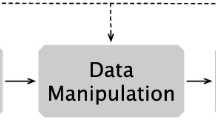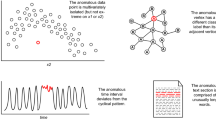Abstract
In time-varying scientific datasets from simulations or experimental observations, scientists always need to understand when and where interesting events occur. An event is a complex spatial and temporal pattern that happens over a course of timesteps and includes the involved features and interactions. Event detection allows scientists to query a time-varying dataset from a much smaller set of possible choices. However, with many events detected from a dataset, each spanning different time intervals, querying and visualizing these events pose a challenge. In this work, we propose a framework for the visualization of events in time-varying scientific datasets. Our method extracts features from a data, tracks features over time, and saves the evolution process of features in an event database where a set of database operations are provided to model an event by defining the stages or individual steps that make up an event. Using the feature metadata and the event database, three types of event visualizations can be created to give a unique insight into the dynamics of data from temporal, spatial, and physical perspectives and to summarize multiple events or even the whole dataset. Three case studies are used to demonstrate the usability and effectiveness of the proposed approach.
Graphic abstract











Similar content being viewed by others
References
Aggarwal JK, Ryoo MS (2011) Human activity analysis: a review. ACM Comput Surv (CSUR) 43(3):16
Albanese M, Chellappa R, Moscato V, Picariello A, Subrahmanian VS, Turaga P, Udrea O (2008) A constrained probabilistic petri net framework for human activity detection in video. IEEE Trans Multimed 10(8):1429–1443
Bemis KG, Silver D, Xu G, Light R, Jackson D, Jones C, Ozer S, Liu L (2015) The path to COVIS: a review of acoustic imaging of hydrothermal flow regimes. Deep Sea Res Part II Top Stud Oceanogr 121:159–176
Born S, Wiebel A, Friedrich J, Scheuermann G, Bartz D (2010) Illustrative stream surfaces. IEEE Trans Vis Comput Graph 16(6):1329–1338
Brambilla A, Carnecky R, Peikert R, Viola I, Hauser H (2012) Illustrative flow visualization: state of the art, trends and challenges. Vis Orient Vis Design Flow Illus. https://doi.org/10.2312/conf/EG2012/stars/075-094
Caban J, Joshi A, Rheingans P (2007) Texture-based feature tracking for effective time-varying data visualization. IEEE Trans Vis Comput Graph 13(6):1472–1479
Clyne J, Mininni P, Norton A (2013) Physically-based feature tracking for CFD data. IEEE Trans Vis Comput Graph 19(6):1020–1033
Ellsworth D, Chiang LJ, Shen HW (2000) Accelerating time-varying hardware volume rendering using tsp trees and color-based error metrics. In: 2000 IEEE symposium on volume visualization (VV 2000). IEEE, pp 119–128
Hauser H (2006) Generalizing focus+ context visualization. In: Scientific visualization: the visual extraction of knowledge from data. Springer, Berlin, Heidelberg, pp 305–327
Hsu WH, Mei J, Correa CD, Ma KL (2009) Depicting time evolving flow with illustrative visualization techniques. In: International conference on arts and technology. Springer, Berlin, pp 136–147
Iacovelli D (1991) The Saffir/Simpson hurricane scale: an interview with Dr. Robert Simpson
Jankun-Kelly TJ, Ma KL (2001) A study of transfer function generation for time-varying volume data. In: Volume graphics 2001. Springer, Vienna, pp 51–65
Ji G, Shen HW (2006) Feature tracking using earth mover’s distance and global optimization. In: Pacific graphics, vol 2
Ji G, Shen HW, Wenger R (2003) Volume tracking using higher dimensional isosurfacing. In: Proceedings of the 14th IEEE visualization 2003 (VIS’03). IEEE Computer Society, p 28
Joshi A, Rheingans P (2005) Illustration-inspired techniques for visualizing time-varying data. In: VIS 05. IEEE visualization, 2005. IEEE, pp 679–686
Joshi A, Rheingans P (2008) Evaluation of illustration-inspired techniques for time-varying data visualization. Comput Graph Forum 27(3):999–1006
Joshi A, Caban J, Rheingans P, Sparling L (2009) Case study on visualizing hurricanes using illustration-inspired techniques. IEEE Trans Vis Comput Graph 15(5):709–718
Kang D, Curchitser EN (2013) Gulf Stream eddy characteristics in a high-resolution ocean model. J Geophys Res Oceans 118(9):4474–4487
Lavee G, Rivlin E, Rudzsky M (2009) Understanding video events: a survey of methods for automatic interpretation of semantic occurrences in video. IEEE Trans Syst Man Cybern Part C (Appl Rev) 39(5):489–504
Lee TY, Shen HW (2009) Visualizing time-varying features with tac-based distance fields. In: 2009 IEEE pacific visualization symposium. IEEE, pp 1–8
Liu L, Silver D, Bemis K, Kang D, Curchitser E (2017) Illustrative visualization of mesoscale ocean eddies. Comput Graph Forum 36(3):447–458
Liu L, Silver D, Bemis K (2019) Visualizing three-dimensional ocean eddies in web browsers. In: IEEE access, pp 44734–44747
Lorensen WE, Cline HE (1987) Marching cubes: a high resolution 3D surface construction algorithm. In: ACM siggraph computer graphics, vol 21, no 4. ACM, pp 163–169
Lu A, Shen HW (2008) Interactive storyboard for overall time-varying data visualization. In: 2008 IEEE pacific visualization symposium. IEEE, pp 143–150
Lum EB, Ma KL, Clyne J (2002) A hardware-assisted scalable solution for interactive volume rendering of time-varying data. IEEE Trans Vis Comput Graph 8(3):286–301
Ma KL (2003) Visualizing time-varying volume data. Comput Sci Eng 5(2):34
Ma KL, Shen HW (2000) Compression and accelerated rendering of time-varying volume data. In: Proceedings of the 2000 international computer symposium-workshop on computer graphics and virtual reality, pp 82–89
Ma KL, Liao I, Frazier J, Hauser H, Kostis HN (2012) Scientific storytelling using visualization. IEEE Comput Graph Appl 32(1):12–19
Muelder C, Ma KL (2009) Interactive feature extraction and tracking by utilizing region coherency. In: 2009 IEEE pacific visualization symposium. IEEE, pp 17–24
Okubo A (1970) Horizontal dispersion of floatable particles in the vicinity of velocity singularities such as convergences. Deep Sea Res Oceanogr Abstr 17(3):445–454
Ozer S, Silver D, Bemis K, Martin P (2014) Activity detection in scientific visualization. IEEE Trans Vis Comput Graph 20(3):377–390
Palmer IJ, Grimsdale RL (1995) Collision detection for animation using sphere-trees. Comput Graph Forum 14(2):105–116
Pfister H, Lorensen B, Bajaj C, Kindlmann G, Schroeder W, Avila LS, Raghu KM, Machiraju R, Lee J (2001) The transfer function bake-off. IEEE Comput Graph Appl 21(3):16–22
Poppe R (2010) A survey on vision-based human action recognition. Image Vision Comput 28(6):976–990
Rautek P, Bruckner S, Gröller E, Viola I (2008) Illustrative visualization: new technology or useless tautology? ACM SIGGRAPH Comput Graph 42(3):4
Reinders F, Post FH, Spoelder HJ (2001) Visualization of time-dependent data with feature tracking and event detection. Visual Comput 17(1):55–71
Rheingans P, Ebert D (2001) Volume illustration: nonphotorealistic rendering of volume models. IEEE Trans Vis Comput Graph 7(3):253–264
Ruppert J (1995) A Delaunay refinement algorithm for quality 2-dimensional mesh generation. Journal offocuses on a single event timestep by timestep algorithms 18(3):548–585
Samtaney R, Silver D, Zabusky N, Cao J (1994) Visualizing features and tracking their evolution. Computer 27(7):20–27
Shen HW, Chiang LJ, Ma KL (1999) A fast volume rendering algorithm for time-varying fields using a time-space partitioning (TSP) tree. In: Proceedings visualization’99 (Cat. No. 99CB37067). IEEE, pp 371–545
Silver D, Wang X (1997) Tracking and visualizing turbulent 3d features. IEEE Trans Vis Comput Graph 3(2):129–141
Viola I, Gröller ME (2005) Smart visibility in visualization. In: Computational aesthetics, pp 209–216
Viola I, Kanitsar A, Groller ME (2005) Importance-driven feature enhancement in volume visualization. IEEE Trans Vis Comput Graph 11(4):408–418
Weiss J (1991) The dynamics of enstrophy transfer in two-dimensional hydrodynamics. Phys D 48(2–3):273–294
Wohlfart M, Hauser H (2007) Story telling for presentation in volume visualization. In: Proceedings of the 9th Joint Eurographics/IEEE VGTC conference on visualization. Eurographics Association, pp 91–98
Acknowledgements
We thank the Department of Environmental Sciences and the Department of Marine and Coastal Sciences at Rutgers University for providing the ocean simulation data and the underwater plume data. We also thank the domain experts who gave us feedback: Guangyu Xu, Darrell Jackson, Russ Light, Dujuan Kang, and Enrique Curchitser. This work has been funded by the US National Science Foundation (NSF) Grants 0825088 and OCE-1049088.
Author information
Authors and Affiliations
Corresponding author
Additional information
Publisher's Note
Springer Nature remains neutral with regard to jurisdictional claims in published maps and institutional affiliations.
Rights and permissions
About this article
Cite this article
Liu, L., Silver, D. & Bemis, K. Visualizing events in time-varying scientific data. J Vis 23, 353–368 (2020). https://doi.org/10.1007/s12650-020-00625-2
Received:
Revised:
Accepted:
Published:
Issue Date:
DOI: https://doi.org/10.1007/s12650-020-00625-2




